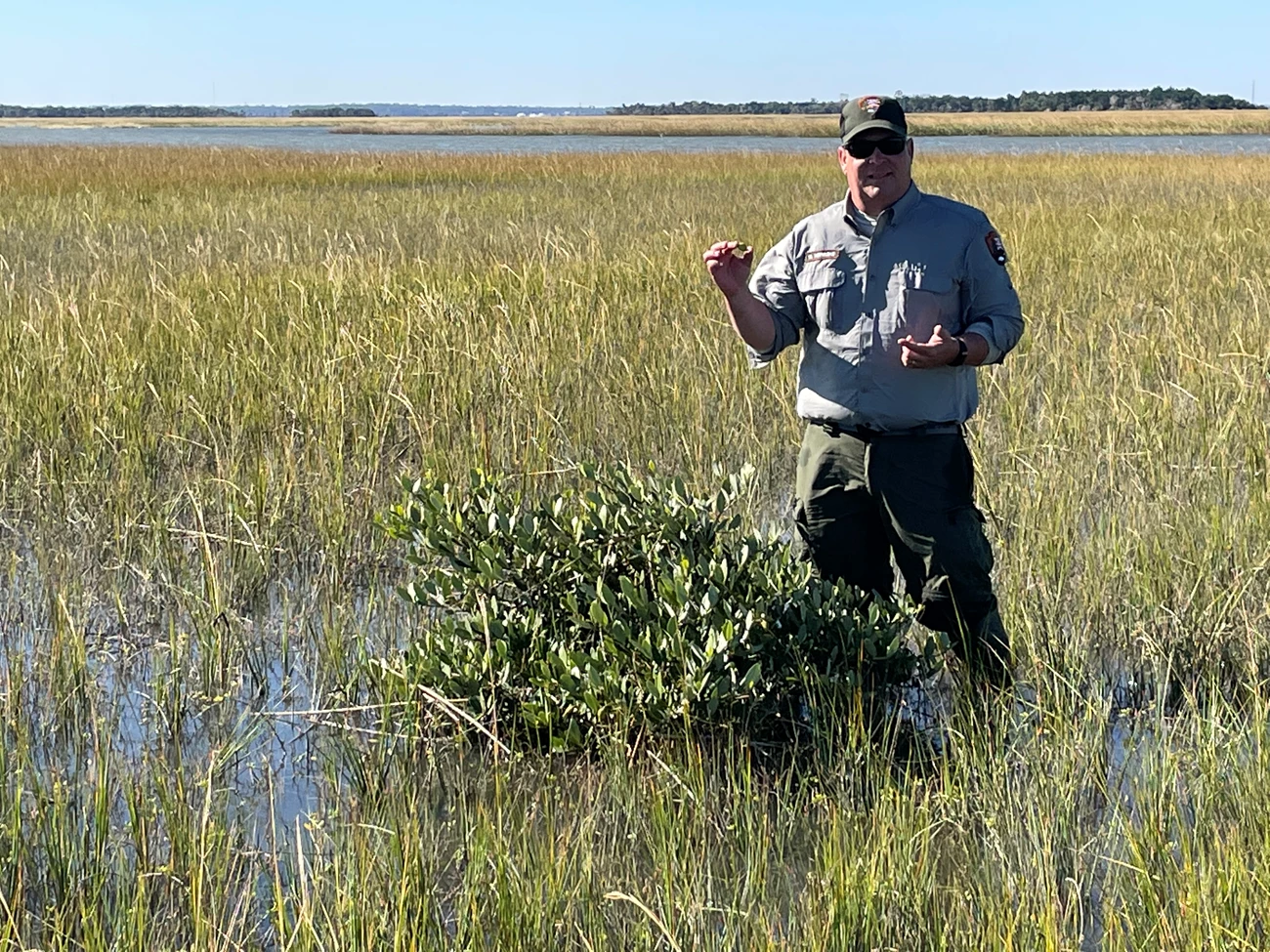Last updated: March 8, 2025
Article
Marching Mangroves: Finding the Most Northern One Is Just the Beginning
The appearance of tropical trees in a historical park foreshadows climate change’s profound impacts on our natural and cultural heritage.
By William C. Vervaeke, Fiona E. Southwell, and E. Claire Schmidt

Image credit: NPS / Fiona E. Southwell
Are there wild animals or plants in your local park that you never saw as a child? If so, they might be arriving because of ongoing climate change. In an upcoming paper, we tell how we recently discovered—for the first time—a large group of mangroves at Timucuan Ecological and Historic Preserve in northeast Florida. These mangroves include what could be the most northern mangrove ever found in North America. Our discovery shows that mangroves now exist further north than previously documented, giving evidence that plant communities are moving in response to climate change. The implications of this shift for our national parks and our nation are profound.
Mangroves are woody, tropical, coastal wetland plants that can tolerate tidal flooding and the salt found in coastal estuaries. In the United States, you can find them along the coast in Texas, Louisiana, and southern Florida. In their native range, mangroves protect coastal structures and habitats from major storm events and provide places for fish to live and breed. There are three species of mangroves native to the U.S.: black, red, and white. The group of mangroves we discovered in a salt marsh at Timucuan on Fort George Island are mainly red mangroves, which are less tolerant of freezes than black mangroves. These red mangroves are less than one year to over four years old, which means they arrived there at different times. The most northern is a red mangrove and is three and a half to four years old, suggesting that it arrived in 2018.
Rising temperatures are causing temperate zones to become more tropical. At the same time, extreme winter weather has decreased in North America, creating favorable conditions for mangrove migration northward. Mangrove trees spread their propagules (a reproductive structure like a seed) through water and tides. More frequent storms could transport these propagules even farther. In 2017, Hurricane Irma left huge amounts of them on Florida beaches outside of where mangroves normally grow. Prior to warmer temperatures and milder winters, these propagules might not have survived. But now they threaten to displace native, more cold-tolerant salt marshes. This could dramatically alter the coastlines of national parks and other natural areas and have deep impacts on the plants and animals that live there.
"Long-term, I fear that large areas of salt marsh will be lost due to mangrove migration, and if we have a sustained freeze that destroys the mangroves, what will we be left with?"
Timucuan’s chief of science and resource management, Steven Kidd, doesn’t know what the full effect of this mangrove migration will be, but it might not be good. “The cultural landscapes at several of our historic sites that are tucked alongside salt marsh habitat, like Kingsley Plantation and Fort Caroline National Memorial, would be completely changed if the mangroves outcompeted and replaced the salt marsh grasses,” he said. “These sites are nationally significant, as they protect important historic structures and archeological resources that teach us about people that inhabited this land hundreds of years ago. They help to tell the story of the lives of enslaved people, the lives of Timucua-speaking people, and conflicts between the French and Spanish. Long-term, I fear that large areas of salt marsh will be lost due to mangrove migration, and if we have a sustained freeze that destroys the mangroves, what will we be left with?”
We think the answer to that question lies in tracking and studying these trees. Stay tuned.
About the authors
William "Ches" Vervaeke is a coastal ecologist with the National Park Service's Southeast Coast Inventory and Monitoring Network. He monitors wetland elevations at seven NPS units along the Atlantic coast. He is enrolled in the University of Louisiana at Lafayette’s Environmental and Evolutionary Biology doctoral program, where he is studying elevation dynamics of black mangroves.
Fiona Southwell is a biological science technician at Timucuan Ecological and Historic Preserve. She is currently working on a community science project that involves building water quality stations and developing an invasive plant management plan.
Claire Schmidt is a physical science technician with the Southeast Coast Inventory and Monitoring Network based at Timucuan Ecological and Historic Preserve. She assists with long-term monitoring of coastal wetlands and shorelines in the Southeast.
